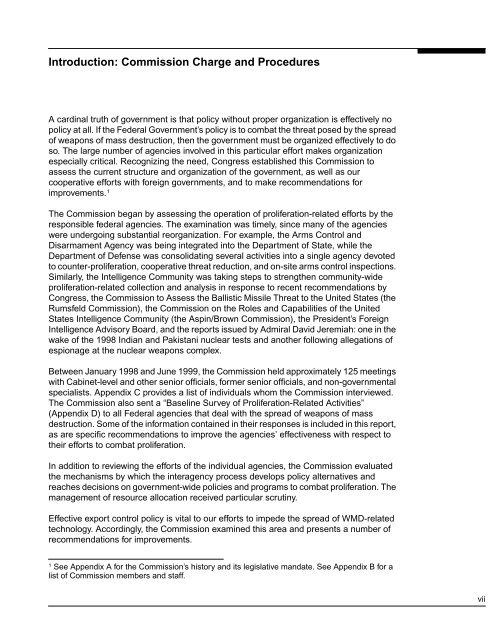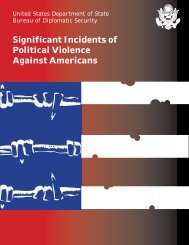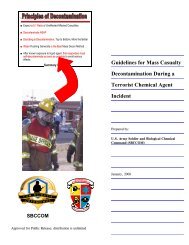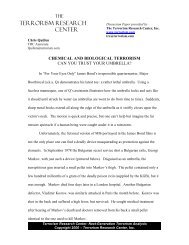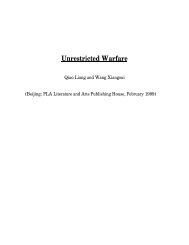Combating Proliferation of Weapons of Mass Destruction
Combating Proliferation of Weapons of Mass Destruction
Combating Proliferation of Weapons of Mass Destruction
You also want an ePaper? Increase the reach of your titles
YUMPU automatically turns print PDFs into web optimized ePapers that Google loves.
Introduction: Commission Charge and ProceduresA cardinal truth <strong>of</strong> government is that policy without proper organization is effectively nopolicy at all. If the Federal Government’s policy is to combat the threat posed by the spread<strong>of</strong> weapons <strong>of</strong> mass destruction, then the government must be organized effectively to doso. The large number <strong>of</strong> agencies involved in this particular effort makes organizationespecially critical. Recognizing the need, Congress established this Commission toassess the current structure and organization <strong>of</strong> the government, as well as ourcooperative efforts with foreign governments, and to make recommendations forimprovements. 1The Commission began by assessing the operation <strong>of</strong> proliferation-related efforts by theresponsible federal agencies. The examination was timely, since many <strong>of</strong> the agencieswere undergoing substantial reorganization. For example, the Arms Control andDisarmament Agency was being integrated into the Department <strong>of</strong> State, while theDepartment <strong>of</strong> Defense was consolidating several activities into a single agency devotedto counter-proliferation, cooperative threat reduction, and on-site arms control inspections.Similarly, the Intelligence Community was taking steps to strengthen community-wideproliferation-related collection and analysis in response to recent recommendations byCongress, the Commission to Assess the Ballistic Missile Threat to the United States (theRumsfeld Commission), the Commission on the Roles and Capabilities <strong>of</strong> the UnitedStates Intelligence Community (the Aspin/Brown Commission), the President’s ForeignIntelligence Advisory Board, and the reports issued by Admiral David Jeremiah: one in thewake <strong>of</strong> the 1998 Indian and Pakistani nuclear tests and another following allegations <strong>of</strong>espionage at the nuclear weapons complex.Between January 1998 and June 1999, the Commission held approximately 125 meetingswith Cabinet-level and other senior <strong>of</strong>ficials, former senior <strong>of</strong>ficials, and non-governmentalspecialists. Appendix C provides a list <strong>of</strong> individuals whom the Commission interviewed.The Commission also sent a “Baseline Survey <strong>of</strong> <strong>Proliferation</strong>-Related Activities”(Appendix D) to all Federal agencies that deal with the spread <strong>of</strong> weapons <strong>of</strong> massdestruction. Some <strong>of</strong> the information contained in their responses is included in this report,as are specific recommendations to improve the agencies’ effectiveness with respect totheir efforts to combat proliferation.In addition to reviewing the efforts <strong>of</strong> the individual agencies, the Commission evaluatedthe mechanisms by which the interagency process develops policy alternatives andreaches decisions on government-wide policies and programs to combat proliferation. Themanagement <strong>of</strong> resource allocation received particular scrutiny.Effective export control policy is vital to our efforts to impede the spread <strong>of</strong> WMD-relatedtechnology. Accordingly, the Commission examined this area and presents a number <strong>of</strong>recommendations for improvements.1See Appendix A for the Commission’s history and its legislative mandate. See Appendix B for alist <strong>of</strong> Commission members and staff.vii


